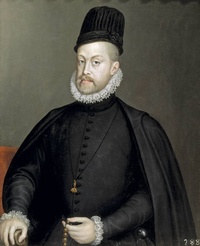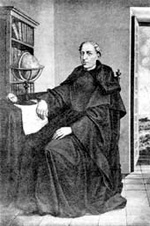While doing research for another article, I found information on the 1596 wreck of the Spanish Manila Galleon San Felipe, which was returning to New Spain (a territory in North and Central America whose main government was located in present-day Mexico) from the Philippines. Loaded with about a million Mexican pesos worth of oriental goods, it also had a party of Franciscan missionaries on board. A nasty Pacific storm forced the vessel into Tosa, Shikoku. As was then customary, everybody wanted a portion of the wrecked goods, except for the friars. Francisco de Olandia, the ship’s Pilot Major, threatened the local authorities with Spain’s power to come and conquer Japan if the cargo was confiscated. However, the Shogunate took the goods, imprisoned the friars, and later executed them1.
Thanks to the favorable easterly winds and marine currents, the voyage from Acapulco, Mexico, to the Spice Islands2 took about eighty days. However, the return—the tornaviaje, as the Spanish called it—was considered impossible. Since 1523, just two years after Cortes destroyed the Aztec Empire, the insatiable conquistadores had been trying to realize Columbus’s dream of reaching Asia by West. Though many galleons had reached the Spice Islands, not one had ever been able to return; those ships that did not end in the Pacific’s bottom, had to limp back to their sailing point or to a safe harbor close by, leaving a lot of mariners stranded in the islands3. With the Portuguese advancing fast in the Pacific, opening a maritime trading route from New Spain to the Pacific Islands and back was the top goal. Finally, on October 8, 1565, an Augustinian friar, Andres de Urdaneta discovered and chartedthe tornaviaje. Or so, history writers claim.
In his younger years, Urdaneta had traveled with Juan Sebastian Elcano in his second voyage of circumnavigation, during which Urdaneta learned many navigational tricks. Elcano died before completing the voyage. His crew, including Urdaneta, ended up stranded in the Pacific Islands for nine long years. Urdaneta finally made it to Lisbon, where the Portuguese seized him, confiscated his charts and put a prize on his head. Urdaneta escaped to Spain, where he recreated much of the confiscated material, and presented it to the Spanish Court. Neither the documents nor the author impressed his August Majesty, Charles V, much. So, Urdaneta decided to look for friendlier waters in Mexico.
Too tired of the bloody conquistador’s life, and feeling quite guilty about it, Urdaneta entered the Augustinian order in Mexico. Meanwhile, Charles V abdicated the throne in favor of his son, Phillip II, The Prudent. Fascinated with the skyrocketing price of spices, Phillip pushed to create a sea route between Spain and the East through Mexico, and chose Urdaneta for the task. For the Church, still subservient to the king under thePatronato Real de las Indias4, it mattered very little that Urdaneta was a friar.
In Phillip’s name, Mexican viceroy de Velasco commanded Urdaneta to find the coveted return route, intrude into Portuguese holdings, seize the Philippines and any other island nearby, and secure the spice monopoly for Spain. To salve his conscience, Urdaneta refused to command the expedition, and pretended to go as a missionary to rescue the Spanish souls marooned way down there. And so, a group of four galleons left Acapulco in November 1564, under the command of Miguel Lopez de Legazpi with Urdaneta as navigational expert. After quite a bit of roaming, three ships finally landed in the Philippines, and conquered them for Spain in April 1565.
Since the return mission had to be accomplished pronto, Legazpi asked Fr. Urdaneta to take the San Pedro, the best galleon in the fleet, and get it ready for the tornaviaje with Legazpi’s grandson, 18-year old Felipe de Salcedo, as captain. They left in June 1565.
More on a hunch than on real experience, Urdaneta had the San Pedro climb northeast to 39-40˚ N. latitude and 170 W. longitude, to bypass the easterly winds, find the Kuroshio—the Japan or Black Current5—and use the favorable air currents blowing from Asia. Later, the ship descended to 30˚N latitude, and then climbed up again to 39˚30'N latitude6, unnecessarily extending and jeopardizing the crucial trip. In all that meandering, over 14,000 miles in 130 days, sixteen of the 44-member original crew died, and the rest became miserably ill.
On October 8, 1565, the ship finally limped into Acapulco, in disrepair and with almost every hand at the verge of death. Urdaneta and young Salcedo had to man the anchors7. Urdaneta justified the fumbling as the need to certify the route. Upon returning, he became Spain’s new navigational star. Someone soon dubbed him “The Columbus of the Pacific” and his wisdom and maritime knowledge became highly celebrated. Now Spain could boast two super-heroes: Christopher Columbus and Fray Andres de Urdaneta.
Like many other grandiose tales, the above begs for the traditional grain of salt.
Midway—or somewhere else along the route to the East—Alonso de Arellano, another officer of the original Legazpi expedition, decided to bolt, and sped to the Philippines on his own. He was in charge of the faster and more maneuverable patache8 San Lucas. In the process, he discovered eight islands, including Truk; reached the Philippines before Legazpi and Urdaneta; and came back to Mexico in July 1565, more than two months ahead of the Nuevo Colon.
However, Urdaneta, well connected with Mexico and Spain’s grandees, got the fame and recognition. Arellano’s report of the trip was provable, unfortunately, his records and charts were less than optimal. He died in relative obscurity, but at least with his head still on his shoulders.
At some point in modern history, some restless anthropologists decided to launch the exciting thesis that, most likely, eons before Messrs. Columbus, Arellano, and Urdaneta, Asian mariners had managed to cross the Pacific Ocean, and land on the tropical shores of Mexico, Ecuador, and a few other places in Central and South America.9
In Mexico, the fun began around 1895, when, during that year’s Congress of Americanists meeting in Mexico City10, participants discussed the possibility of pre-Columbian trips to America from Asia. In the mid-twentieth century, while studying the Otomi cultures, anthropologist and historian Eulalia Guzman11 theorized that the chance was quite high. Later, the top Mexican ethnographer and artist Miguel Covarrubias,also supported the concept of transpacific voyages.And two other Mexican-born anthropologists, Celia Heil (1998) and Jorge Olvera (2000), found strong similarities between the native peoples they studied and the “Ancient Japanese.”
For me, this is a discovery trip far more exciting than finding the tornaviaje route. And I hope that I can sustain your interest with all its thrills for the next three issues.
Notes:
1. Boxer, C.R. The Christian Century in Japan, 1549-1650. Manchester, UK: Carcanet Press. 2001.
2. Mainly the Moluccas, an archipelago in Indonesia.
3. For the entire saga of Pacific explorations see: http://epress.anu.edu.au/spanish_lake/mobile_devices/index.html
4. Pope Julius II, 1508, gave the King of Spain absolute authority over all ecclesiastical matters in the colonies (New World), leaving The Church subject to the whims of the monarchs, overseas and at home.
5. The Kuroshio Current, about 50 miles wide and l mile deep, starts around Taiwan, flows in a NE direction along the eastern shores of Japan, at the speed of 3-4 knots; merges with the North Pacific Current and flows E. to the Pacific. One of its branches, the California Current, flows along North America’s west coast to Lower California. For other details about the current’s features, see: Ebbesmeyer, Curtis & Eric Scigliano: Flotsametrics and the Floating World. New York: HarperCollins. 2009; p/157 & App.”C” (Turtle gyre.).
6. Historians don’t agree on the exact coordinates of the trip.
7. In celebration of the 440th anniversary (2005) of Urdaneta’s ‘discovery,’ a slew of panegyric work appeared in Spain and The Philippines. Some of those pieces portray Urdaneta almost as a saint... See also: Cuevas, MarianoMonje y marino; la vida y los tiempos de fray Andrés de Urdaneta. México: Galatea.1943. (out of print.) And http://epress.anu.edu.au/spanish_lake/mobile_devices/index.html - from the Australian National University.
8. Usually faster and lighter than the other vessels in an expedition; the patacheprovided the other galleons personnel supplies, communication, or storage for booty.
9. The supporters of inventionist/convergence claim that after their crossing the Bering area, what became ‘Native Americans’ developed their cultures at their own pace, free from external influences. Similarities noted between these cultures’ products and those from the Old World are pure convergences.
Diffusionists argue that substantial clues exist about contacts and mutual cultural influences between prehistoric and ancient peoples from overseas and those from America, and that such contacts seem to occur continuously.
10. The Congress has met again in Mexico several times, and most recently in July 2009.
11. Ms. Guzman is the first Mexican woman to be recognized as an anthropologist. Her work is truly immense, and it includes the organization of the entire archive of the National Institute of Anthropology and History (INAH) of Mexico.
© 2010 Edward Moreno








